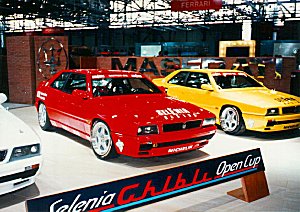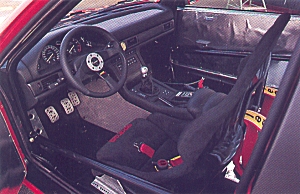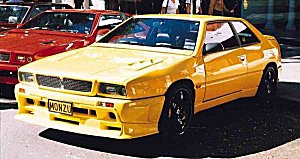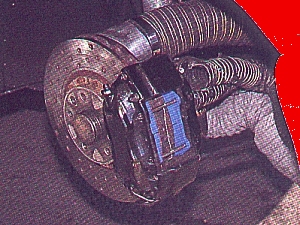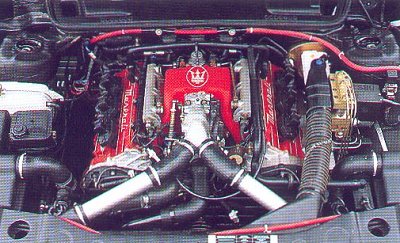|
If you own are the lucky owner of a 'Ghibli Cup', I would appreciate your help. I am trying to ascertain the exact number of 'Ghibli Cups' produced. Please send me the series number of your 'Cup' along with the chassis number. I will publish my findings on this page when all 'Cups' are accounted for.
Many thanks to Paul Negyesi for his permission to use this photo and excerps of his text.
At the 1995 Geneva Motor Show Maserati exhibited the new Quattroporte, the Ghibli and the Shamal.
Star of the stand was the Ghibli 'Open Cup' racing version.
In response to the disappointing sales
of the new Ghibli II and in an effort to boost sales, new owners Fiat decided to launch the Selenia Ghibli Open Cup race series for 1995.
The one marque race series was based on the Italian road car's 2-litre 306bhp engine with
25 Cups being built for one-marque championship (plus a further two for collectors at the end of the season).
The Ghibli 'Open Cup' sold for L.120.000.000 (£48,000) with a further L.23,000,000 (£9,000) payable to enter the Championship. This fee
covered all entry fees, tyres, circuit passes, Maserati race and paddock clothing and of course (if you'll excuse the pun) the excellent 'Maserati Hospitality'.
Technical backup was provided to entrants by Maserati's chief engineer, Giorgio Gamberini.
At the end of the season Maserati S.p.A. refunded L.10,000,000 (£4,000) to any driver that
competed in all rounds and if the owners wanted, their cars were converted for road use and sold.
To ensure competitive racing all engines were sealed before leaving the factory and regulations
stated that the winning car in any race carried 25kg of ballast in the next race.
The 1995 race series consisted of 9 races, five of which were held simultaneously with DTM events.
The calendar for 1995 was as follows:
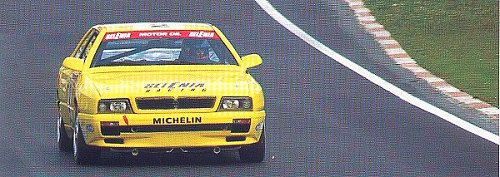
The 1995 series was a great success and a new series was planned for 1996. It is said that all competing cars finished the season without a single engine rebuild but the main cause of complaint amongst the drivers were the brakes, or lack of them!
For the 1996 series nine races were planned starting at Monza in March and
ending at Mugello in September. Eligible cars were the 1995 cars now carrying a Maserati upgrade
kit and the new 1996 Ghibli Open Cup 'Evoluzione'. Cars had their engine, gearbox, turbochargers
and differential sealed prior to delivery. As a further measure to promote competitive racing the
winner carried 40kg of ballast in the following race. Grid positions were decided by a draw amongst
the top six qualifiers.
Modifications made for the new season included new silencers, don't laugh but
apparently some drivers complained about the lack of 'noise'! A redesigned braking system
included larger discs with bigger four-pot calipers. The larger brake discs required 18 inch
wheels which were supplied by TechnoMagnesio. The front suspension was redesigned and was
fully rose jointed, the rubber bushing being replaced. Aerodynamics were improved with a new
lower front spoiler incorporating larger air intakes for improved cooling of the turbos and
brakes together with a boot mounted rear spoiler. All competitors were supplied with six slicks
or wets for each race.
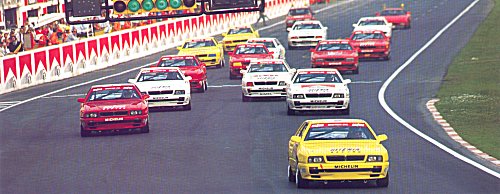
The healthy L.390,000,000 (£160,000) prize fund ensured that the first 14 places received prizes ranging from L.6,000,000 (£2,400) to L.250,000 (£100). Trophies and cash prizes were to be awarded for a variety of categories including best gentleman driver, best lady driver, best gentleman driver over 50 and best driver under 25. Everything was in place for a really successful season. What happened? After two races Fiat pulled the plug as they considered the rising costs outweighed the commercial benefits. The good news was that some lucky owners benefited from Maserati's decision to produce a
road going version known as the 'Ghibli Cup'.
The 'Open Cup' 2-litre engine prepared by Maserati in conjunction with Alfa Corse and boosted to 330
bhp at 7000 rpm with new low friction ball-bearing turbocompressors fed by larger intercoolers, revised
engine management system and straight through exhaust.
| ||
